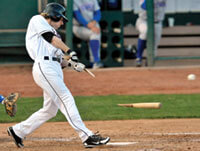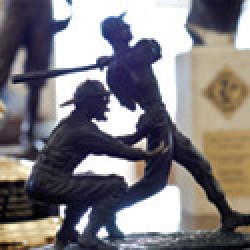Bat Man

The crack of the bat: a hitter shatters his bat in a minor league game. The flying shard of wood can be dangerous to other players and fans. David Kretschmann and his colleagues have helped Major League Baseball reduce the number of shattered bats by half. © Kirk Speer, the Colorado Springs Gazette. All rights reserved.
David Kretschmann is working to make baseball bats break safely.
David Kretschmann ’84, MS’87 likes to see wood crack.
“I break things for a living,” he says. Kretschmann is an engineer with the Forest Products Lab, a U.S. Department of Agriculture facility located on the UW campus. As such, he’s interested in seeing how much stress lumber can take and remain in one piece.
It was this work that brought him to the attention of Major League Baseball. In 2008, the sport was suffering an epidemic of shattered bats — that is, bats that break into multiple pieces, often sending sharp splinters flying toward players and fans. That year saw an average of one shattered bat per game, and baseball executives grew concerned enough to ask for help from Kretschmann and several other scientists. The group examined all the bats that had shattered in the last three months of the season, and found that the problem lay largely in the wood itself: more and more bats were made of maple.
“Traditionally, bats were made out of white ash,” says Kretschmann. “But then Barry Bonds started using a maple bat, and he hit [a record] seventy-three home runs in one season. Then the use of maple bats took off. Today, about 60 percent of bats are made of maple, where in 1990, that figure was only about 3 percent, if that much.”
The problem lies in what woodworkers call “slope of grain.” A baseball bat (or any piece of lumber) is strongest when cut with its length parallel to the grain of the wood. If the slope of grain differs from the center line of the bat by as little as 3 degrees, that bat will be 20 percent more likely to shatter.
Maple isn’t necessarily a weaker wood than ash, Kretschmann explains. Rather, it has a less well-defined grain. Because ash has a clearly defined face grain, it’s easy for manufacturers to make strong bats. But maple’s poorly defined face grain makes it harder to judge how to cut the wood properly.
Kretschmann and his colleagues came up with a simple solution for that problem. Before a piece of wood is carved into a bat, inspectors now paint a spot of ink onto it. The wood draws up the ink, showing the direction of its face grain. “It took a while [for manufacturers] to get used to doing this efficiently,” Kretschmann says, “but we saw an immediate drop [in the number of shattered bats].”
From an average of one per game in 2008, the number fell to .65 shattered bats per game by the end of the 2009 season, and to .55 by the end of 2010. In the first half of 2011, it reached .45.
“This is not to say we’ve solved the problem,” Kretschmann says. “It’s tricky to get everyone to accept our recommendations. But the numbers are down well over half. From my point of view, that’s something.”
Published in the Fall 2011 issue



Comments
mavfan October 9, 2011
Interesting. Wondering if the control group is skewed a bit since the steroid crackdown happened in 09?
Patricia August 7, 2013
Do you have a recommendation for a kitchen counter finished only with mineral oil? I’ve used teak in a previous kitchen but it’s too orange for the current one. I’d like to cut groves to drain dishes. I’ll keep the grain parallel to the counters edge.
Thanks.